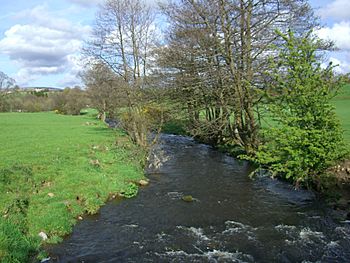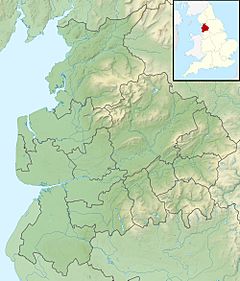River Conder facts for kids
Quick facts for kids River Conder |
|
|---|---|

River Conder near Ellel
|
|
|
Location of the mouth within Lancashire
|
|
| Country | United Kingdom |
| Part | England |
| County | Lancashire |
| Physical characteristics | |
| River mouth | Lune estuary 53°59′57.5″N 2°50′0″W / 53.999306°N 2.83333°W |
The River Conder is a small river in the English county of Lancashire. It flows through the countryside before joining a larger river.
Contents
What is the River Conder?
The River Conder is a natural waterway. It is one of many rivers that flow through the beautiful landscape of Lancashire. Rivers like the Conder are important for the environment. They also help shape the land around them.
Where Does the River Conder Start?
The River Conder begins its journey at a place called Conder Head. This is a spring found on Black Fell, near Littledale. A spring is where water naturally flows out of the ground.
From its start, the stream first flows north. Then it turns west, moving through an area known as Cragg Wood.
How Was the Conder Valley Formed?
After Cragg Wood, the river flows around Quernmore. It moves in a southwesterly direction. The valley it flows through is very wide for such a small river.
This wide valley was created by something called "glacial action." This means that long ago, huge sheets of ice, called glaciers, moved across the land. As they moved, they carved out the valley, making it much wider than the river itself could.
Where Does the River Conder Flow?
The River Conder continues its path through the villages of Ellel and Galgate. After passing these areas, the river turns towards the north-west.
Its journey ends when it flows into the Lune estuary. An estuary is where a river meets the sea, and the water becomes a mix of fresh and salt water. This meeting point is located between Conder Green and Glasson Dock.
What Does the Name "Conder" Mean?
The name of the River Conder has a long history. Records from the 13th century show it was called Kondover and Kondoure.
These names come from an old language called Brythonic. In Brythonic, the name means "crooked waters." This is a good description, as rivers often have bends and turns, making them look "crooked."


